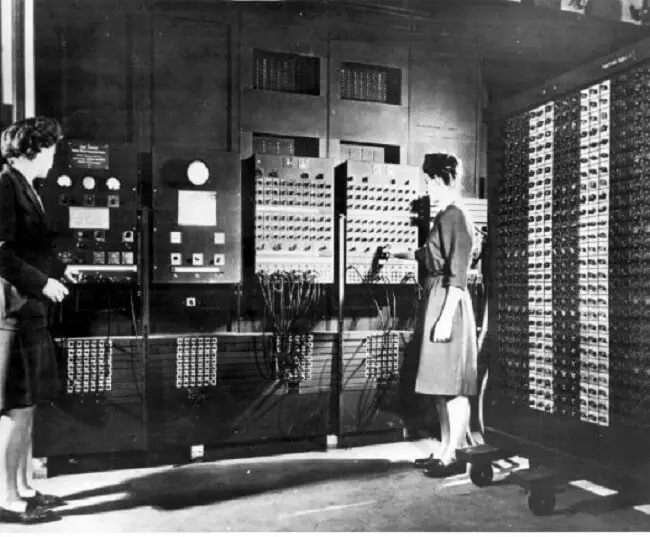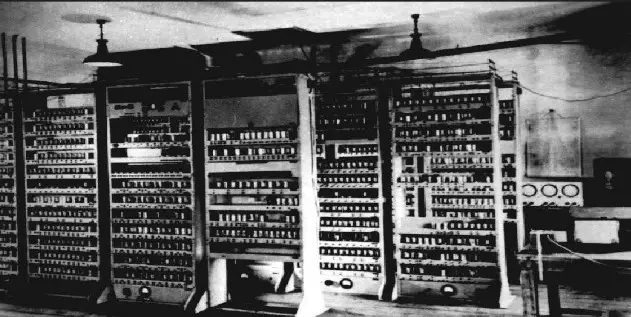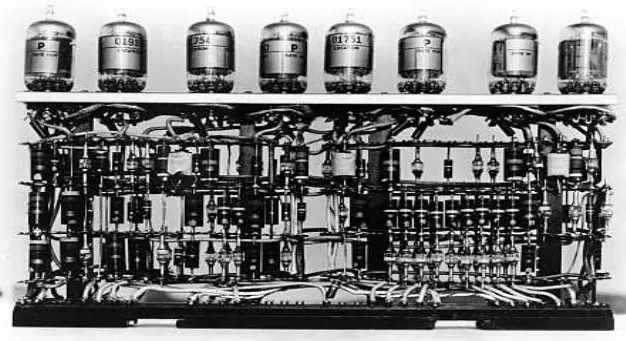➤ Computer Generation
➤ First Generation
➤ Second Generation
➤ Third Generation
➤ Fourth Generation
➤ Fifth Generation
➤ Basic of Programming
➤ Computer Systems
➤ Virtual Machine
➤ Advantages of Open Source Software
➤ Open Source Software Advantages and Disadvantages
➤ Applications of Computer in Business
The first generation of computer was very different from today’s computers. The first generation of computers was based on vacuum tube technology. The batch processing operating system was used in the first generation of computers.
Currently, there are thousands of programming languages like C/C ++, Java, Python, etc. are available to simplify our tasks. But at the time of the first generation of computers, programming languages were not developed. At that time only machine code was used. All input methods were a machine language, and it was known as 1GL (first generation languages). The 1GL was the lowest-level or machine level language.
The machine language is understood by computers, and computers only work on machine language code. At that time the computer was mostly only one type of design. The 1st generation of computers was not made for the general markets. The computers of the first generation were very expensive and only the big organizations or rich people were able to buy them.
- History
- Picture of First Generation Computer
- First Generation Computer Examples
- Vacuum Tube Generation computers
- Features of First Generation Computer
- Technology Used to Develop 1st Generation Computer
- Characteristics of First Generation Computer
- Advantage of First Generation Computer
- Limitations
- Disadvantages
- Summary
History
In 1918, two scientists (Eccles and Jordan) used vacuum tube amplifiers to produce a train. In 1939, a prototype of the Atanasoff-Berry computer was created which is called the first vacuum computer.
The vacuum tube machines (colosis, etc..) were used to break Japanese and German ciphers in world war-2. Approx 1,800 to 2,400 vacuum tubes were used in each colosis vacuum computer. Apart from this, Konrad Jewe had built electro-mechanical binary computers.
In 1942, an experimental electronic computer circuit was made with 100 tubes, but this circuit was destroyed in an air raid.In 1945, a new computer system was developed in the United States, called ENIAC computer.
Generally, In the world war-2 (1939-1945) era developed computers are known as the first generation computers. The time period of the first generation of computers was 1946-1959. The first computer built with a vacuum tube in 1946 is called ENIAC. The Ferranti Mark-1 was created in 1951, and it is considered to be the first commercial vacuum tube computer.
Picture of First Generation Computer
First Generation Computer Examples
Examples of first generation computers are:-
- ENIAC
- EDSAC
- EDVAC
- UNIVAC
- IBM-701
- IBM-650.
Let us discuss them in short.
ENIAC
ENIAC (Electronic Numerical integrator and computer) known as the first operational electronic general-purpose computer. It was built in 1946.
In ENIAC the vacuum tube was used for the memory and logic circuitry of the CPU (Central Processing Unit). Overall 17,000 vacuum tubes, 10,000 capacitors, and 70,000 resistors were used to build this computer. It took 15,000 square feet space, and the weight was 30 tons. It seemed like a whole room. In this computer, the paper tape, magnetic tape, punch cards were used as input, and printouts were used as output.
ENIAC was programmed with switches and plugboards. It was used in the calculation related to the development of nuclear bombs, and it was able to compute almost the rate of 2,000 additions per second.
Two American scientists J. Presper Eckert (1919-1995) and John Mauchy (1907-1980) were the inventors of ENIAC. The ENIAC stands for Electronic Numerical Integrator and Computer. It was constructed with University of Pennsylvania’s Moore School of engineering under government funding. J. Presper Eckert and John Mauchy were the chief designers.
The ENIAC was almost 5000 times faster than MARK-1. MARK-1 is considered to be the first big electronic machine.
Others
EDSAC:- In 1949, John von Neumann developed a new machine called EDSAC (Electronic Delay Storage Automatic Calculator). EDSAC had the capability of storing programs. John Von Newman is known as the father of modern computers.
EDVAC:- EDVAC (Electronic Discrete Variable Automatic Computer) was developed by J. Presper Eckert and John Mauchly. It was one of the earliest electronic computers.
UNIVAC:- In 1951, J.P.Eckert and John Mauchly built a new machine called UNIVAC (Universal Automatic Computer). It was commonly recognized as the first modern computer, and it was the commercial computer that was delivered to business clients. UNIVAC was also the end of the first generation of computers.
Vacuum Tube Generation computers
In 1946, the first computer was made with a vacuum tube. Therefore the first generation computer is also called vacuum tube computers. The chief component of the first generation computer was the vacuum tube.
17,000 vacuum tubes were used in this first computer ENIAC. ENIAC consumed 150 kilowatts of power. The vacuum tube was used for memory and logic circuits. This computer was able to solve only linear equations. It was not a general-purpose computer and was not very reliable too.
In the 1960s, vacuum tube computers were made constant, which was also manufactured by computers with the second generation transistor. The vacuum computer was mostly only one type of design.
Features of First Generation Computer
The first generation computers having following features,
- Vacuum tube technology
- Very expensive
- Consumed a high electricity
- Generated a large amount of heat
- Large size
- Only machine language can be used
- The device was working very slow
- Incredible
- Non-portable
- AC requirement in system
Technology Used to Develop 1st Generation Computer
There were many technologies used to develop the first generation computer, and these are:-
- Vacuum tubes were used as CPU (Central Processing Unit), a magnetic drum for storage.
- Magnetic tape, punch cards, printouts were used as input and output.
- Magnetic core memory was used for primary memory.
The first-generation computers used the batch processing operating system, and these computers were directed by the machine language.
Characteristics of First Generation Computer
First generation computers having following characters,
- The first generation computer was based on various techniques from today’s techniques. These computers were based on vacuum tubes.
- At that time the computer operating system was very slow. A batch processing operating system was used on these computers.
- Machine language was used in the first generation of computers.
- These computers were very large sizes.
- Very high power of electricity was used in the first generation of computers.
- These computers were producing a lot of heat.
- The first generation computer was difficult to program and use.
Advantage of First Generation Computer
- The main advantage of the first generation computers were,
- At that time only electronic components were available. The computer was made by a vacuum tube.
- These computers could solve general calculations.
- At that time computer technology was the first step in the world, so the computer was very useful for the next generation of computers.
- These computers were used in the calculation related to the development of atomic bombs.
Limitations
The first generation was the first step towards the invention of the present form of the computer. Hence, these computers had many limitations. Compared to the next generation of computers it has the following limitations:
- This computer was limited to large calculations and general calculations.
- The first generation computer was solving only one problem at a time, it was not able to understand the multi-tasking work.
- This computer had taken the time of days or weeks to set up a new problem.
- There was very small storage in computer memory.
- Computers of that time were very slow, very large, and highly expensive.
- These computer systems used a great amount of electricity and produced a lot of heat. The more heat was often the cause of the spoiler of the computer.
Disadvantages
- The first generation computer was very expensive.
- These computers were very large in size. The computer took 15,000 square feet space.
- The weight of this computer was 30 tons. The computer seemed like a whole room.
- Too much electricity consumed by these computers.
- These computers had produced high amounts of heat.
- The vacuum tube was used in this computer system, so a large cooling system was required.
- In this computer, only small amounts of information could be stored.
Summary
Q) What is the period of the first generation computer?
Answer:- The period of the first-generation computers is 1946-1959.
Q) Tell me some first-generation computer names?
Answer:- ENIAC, EDSAC, EDVAC, UNIVAC, IBM-701, IBM-650
Q) The first generation of computers was based on which technology?
Answer:- The first generation of computers was based on vacuum tube technology.
Q) First generation computer used for what purpose?
Answer:- The first generation computers were mainly used to solve calculations.
If you enjoyed this post, share it with your friends. Do you want to share more information about the topic discussed above or do you find anything incorrect? Let us know in the comments. Thank you!




This is very useful and helpful for better understanding 👍 👏